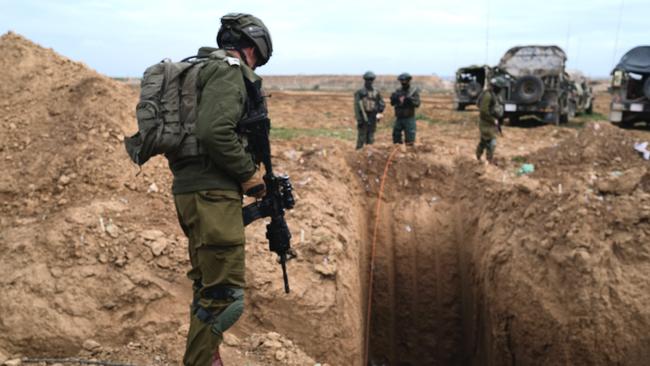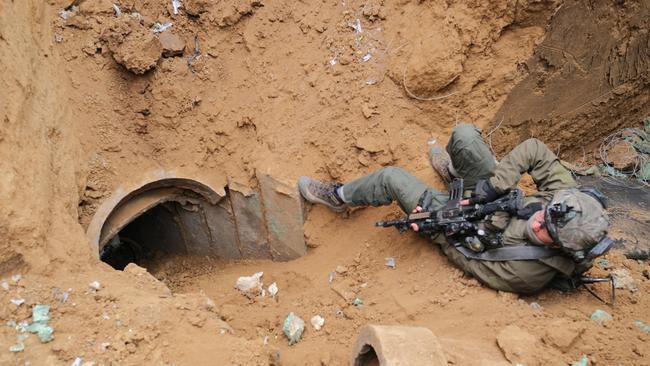As rookie soldiers in Israel take their first tentative steps on to the battlefield in Gaza, there are three lessons they quickly absorb to survive the guerilla tactics of Hamas.
The first is to never chase anyone into a building – in all likelihood it’s a trap. The second is that the militants will almost never wear a uniform – instead they’ll wear hoodies and sweatpants to blend into the population.
And the third lesson is critical. Inside almost every school, every mosque, every second or third home is a shaft dug into a subterranean tunnel system so vast and meticulously constructed that it’s known to the world as the Gaza Underground.
“We paid a heavy price in the beginning, learning this,” says Lieutenant Colonel Anshel, the assistant chief of the 55th paratroopers brigade deployed in Khan Younis, the second-largest city in the territory.
In this uncertain terrain of close-quarter fighting and confusion, the battles in Gaza combine the tunnel warfare of the Vietcong, the dense urban settings of Fallujah, and enemies who deliberately disguise themselves as civilian non-combatants.
Now into the fourth month of its campaign, the Israel Defence Forces have already laid siege to the north of Gaza in November using armoured tanks and precision airstrikes, picking off battalion leaders to slowly degrade Hamas’s command and control structure.
Phase two of this effort has shifted forces to the south of the territory. The IDF is now deep in the prized region of Khan Younis, a hot-zone of terrorist activity where troops are advancing west on a hunt for Hamas’s chief in Gaza, Yahya Sinwar, The Butcher of Khan Younis, and arguably the IDF’s most high-value target.
Here, too, thought to be hiding in the tunnels beneath the city is the commander of Hamas’s military wing, the elusive Mohammad Deif, known by that name because of a longstanding tendency to move locations for security purposes. Deif is a nom de guerre that roughly translates to “Mohammed the Guest”.
And like everywhere else in this strip of land, Khan Younis is densely packed with civilians, including tens of thousands who fled the north on Israel’s orders and are now huddled in humanitarian zones close to the Mediterranean.
On every measure, the IDF is the superior army with unmatchable firepower and technological capabilities. But in an unconventional war against an unconventional foe, Israeli soldiers have learned the hard way to adapt to Hamas’s brand of guerilla fighting, said Anshel.

Last month, on day three of his deployment, the brigade chief launched a surprise raid with his soldiers on a primary school in the middle of the night, clearing each room until the building was empty of every last militant who had been fortified inside.
But in the rush to secure the premises they missed a tunnel shaft secreted in the basement. A few hours later, as the first rays of morning light appeared, militants crept through the tunnel, climbed a set of stairs, and fired an rocket-propelled grenade at the unsuspecting Israeli forces.
“They surprised us,” he said. “We lost in the very first few seconds two soldiers plus 12 more injured.”
Three of the militants were killed in the brief gunbattle that ensued, while a fourth managed to escape back into the tunnel shaft. In the chaos and panic, a sniper caught a glimpse of Anshel through his scope, squeezing off a shot as the soldier stood guard in the building’s foyer.

“The trajectory was literally parallel to my arm, so it went in here and out in here,” he says, brandishing the flesh where the bullet hit. A grizzled veteran of multiple wars, he took a few days off to convalesce and shrugs his shoulders now about the incident. If anything, it was a wake-up call, and he was back in Khan Younis the following week.
It’s a 90-minute drive from Tel Aviv to the lush, rural staging point in southern Israel where The Australian meets Anshel, our guide for this embedded view of the conflict zone.
Around him are humvees scoring deep tracks in the mud, Jeeps mounted with recoilless rifles, and a dozen soldiers pulling on balaclavas and carrying guns tricked up with laser sights and optical attachments.
They’re standing by for insertion into Khan Younis, a few klicks west, and idling not far from the very border fence where terrorists crashed into Israel on October 7 and massacred 1200 members of the population, the majority of them civilians, an event that triggered a vow from Israeli Prime Minister Benjamin Netanyahu to eradicate Hamas as an entity.
Before the events of that day, Anshel – or “Anshi” as he’s known – was a 46-year-old father with a wife, two teenage daughters and an office job at an IT company.
These days he’s helping to lead 3000 men to secure supply lines and logistic routes for troops battling at the frontline, and aside from the few days of downtime when he caught that bullet in the forearm, he hasn’t seen much of that former life since.

Like almost everyone in Israel, he was roused early on the morning of October 7 by the wail of sirens and alerts that were blowing up his phone. Thousands of Qassam rockets fired from Gaza were beginning to overwhelm the Iron Dome defence system.
By that afternoon, the lieutenant colonel had been ordered with his unit to the kibbutz of Kfar Aza, the site of one of the worst mass killings that day, and where he fought with every other available soldier to take back the village.
That’s where they stayed for the rest of the week, carrying out the “challenging mission”, as he terms it, of pulling bodies from the wreckage – 66 people in total, all of them civilians. He spent the next two months reacquainting himself with his rifle, along with 300,000 reservists called up to fight, and 54 days ago he was trucked into Khan Younis for his first deployment.
The IDF routinely embeds reporters with its troops for the purpose of entering Gaza. To comply with the arrangement, The Australian agreed to provide all photographs and videos taken from inside the conflict zone to the military censor. No restrictions were imposed on any of the material, and the writing itself was not vetted in any form.
Strapped into the back of an open jeep, it’s a short ride over a muddy track that trails out of a banana field on the Israeli side through a tall metallic fence that demarcates the start of Gaza and the beginnings of the battle zone.
It’s a signal of how entrenched Israeli forces are in Khan Younis that, six weeks after they began circling the city, most of this journey takes place on a paved road laid down by IDF engineers.
On the way inside Khan Younis we pass what was once a wealthy neighbourhood, home to sprawling villas and enviable properties, but which has since been reduced by the war to a battered, filthy wasteland of rock, rubble and rubbish.

It’s here, inside an elementary school, where the IDF has established something akin to a supply depot for its soldiers, parking tanks in the school playground, stretching barbed wire at the entrance, setting up a line of portaloos and hanging Israeli flags from the upper level balconies.
Hamas militants had embedded themselves inside this school and the surrounding buildings, says Anshel, all of which were captured in the days-long operation that began on December 5, the day of his deployment.
“We go area by area,” he says. “We encircle it, we make sure all the civilians have left the area. We do our best to make sure that they know we’re coming. We fight between houses, we kill the terrorists, we get their infrastructure, their ammunition – we blow it up, and then move onto the next zone.”
It’s a simple formula that belies the complexity of doing business with Hamas. Typically, its militants appear for only a few seconds out in the open, firing potshots from tunnel entrances and then disappearing to safety. “Our challenge is targeting them in those few seconds when they pop out of the hole,” Anshel says.
In other cases, the challenge is figuring out whether the guy in the street clothing is a harmless civilian or a militant heading towards a hiding spot for an RPG or antitank missile that might be used for a sudden attack.

All over the territory, Hamas has been setting traps for the Israelis. It has recorded the cries of a baby and left it playing on a speaker in a booby-trapped apartment. There was a man seen by soldiers disappearing into a house while holding a knife to a woman’s neck, the premises later determined to have been comprehensively rigged with explosives.
Hamas rarely, if ever, concedes the loss of its militants in day-to-day battles with the IDF, and its health ministry often estimates civilian casualties to be in the order of 24,000 people.
But it’s a number that doesn’t distinguish between its fighters and the non-combatants caught in the crossfire.
For the IDF, the key to victory lies beneath the Gazan sandstone, in the elaborate tunnel system that’s turned the suburbs and cities, over the past decade, into one gigantic military stronghold.
There are three types of tunnels that soldiers encounter, distinguishable by their method of construction. Service tunnels are small, dusty affairs with sandy floors used by militants to shift ammunition and supplies.
Some are spacious numbers with marble flooring and decorative adornments, used exclusively by Hamas commanders, with shafts that rise directly into their homes. “That’s more kind of VIP style,” Anshel says.
The third type of tunnel is used solely for infiltrations into Israel, the exit to one of which was discovered only two weeks ago in a field a few hundred metres from the border fence.
Dozens of tunnel shafts just like it are found daily by the army, and while a hole in the ground might not seem like an obvious answer to succeeding in this war, shutting them off cuts a vital artery for Hamas to continue its guerilla fighting.
Is that what winning finally looks like? Anshel says there will never be a photographic moment of victory for the history books.
“There’s no Iwo Jima with flags going up,” he said. “Every 24 hours we dismantle another 50, 60, 70, 80 shafts, and blow up another two tunnels. You do the maths yourself – it takes time.”



More Coverage
Yoni Bashan is the editor of the agenda-setting column Margin Call. He began his career at The Sunday Telegraph and has won multiple awards for crime writing and specialist investigations. In 2014 he was seconded on a year-long exchange to The Wall Street Journal. His non-fiction book The Squad was longlisted for the Walkley Book Award. He was previously The Australian's NSW political correspondent.
Add your comment to this story
To join the conversation, please log in. Don't have an account? Register
Join the conversation, you are commenting as Logout